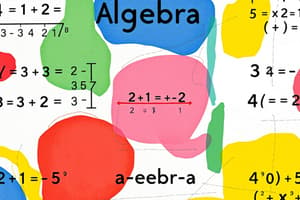Podcast
Questions and Answers
What is a Two-Way Table?
What is a Two-Way Table?
- A way of organizing data from one categorical variable
- A way of organizing data from two categorical variables (correct)
- A type of graph to show relationships
- A table that displays numerical data in two dimensions
A categorical variable can take on numerical values.
A categorical variable can take on numerical values.
False (B)
What is a characteristic of individuals in a population called?
What is a characteristic of individuals in a population called?
Variable
What is a Relative Frequency Table?
What is a Relative Frequency Table?
What is an Association in statistics?
What is an Association in statistics?
What does the term Residual refer to?
What does the term Residual refer to?
What is the range of the Correlation Coefficient?
What is the range of the Correlation Coefficient?
A strong relationship means that the data is loosely spread around the best fit line.
A strong relationship means that the data is loosely spread around the best fit line.
What indicates a Positive Relationship?
What indicates a Positive Relationship?
What indicates a Negative Relationship?
What indicates a Negative Relationship?
A weak relationship means that the data is tightly clustered around the best fit line.
A weak relationship means that the data is tightly clustered around the best fit line.
What is a Causal Relationship?
What is a Causal Relationship?
Flashcards
Categorical Variable
Categorical Variable
A variable that can be divided into distinct groups or categories.
Two-Way Table
Two-Way Table
Organizes data from two categorical variables to show associations.
Relative Frequency Table
Relative Frequency Table
A two-way table where cell values are percentages of total responses.
Association (Statistics)
Association (Statistics)
Signup and view all the flashcards
Variable (Statistics)
Variable (Statistics)
Signup and view all the flashcards
Strong Relationship (Stats)
Strong Relationship (Stats)
Signup and view all the flashcards
Positive Relationship
Positive Relationship
Signup and view all the flashcards
Negative Relationship
Negative Relationship
Signup and view all the flashcards
Weak Relationship
Weak Relationship
Signup and view all the flashcards
Correlation Coefficient
Correlation Coefficient
Signup and view all the flashcards
Residual
Residual
Signup and view all the flashcards
Causal Relationship
Causal Relationship
Signup and view all the flashcards
Study Notes
Two-Way Table
- Organizes data from two categorical variables
- Used to investigate associations between variables
Categorical Variable
- Takes on values that can be divided into distinct groups or categories
- Example: Colors like red, blue, green
Variable (Statistics)
- Represents a characteristic of individuals in a population
- Can assume different values
Relative Frequency Table
- A type of two-way table where cell values are divided by the total number of responses
- Can be calculated for the entire table, rows, or columns
- Useful for demonstrating relationships, such as textbook condition versus price
Association
- Indicates a statistical relationship between two variables
- If one variable's value can help estimate the other, an association is present
Residual
- Refers to the difference between the actual y-value and the predicted y-value from a linear model
- Visualized as dashed lines in scatter plot diagrams
Correlation Coefficient
- Ranges from -1 to 1, highlighting the strength and direction of a linear association
- A value close to 0 indicates a weak relationship, while values near 1 or -1 denote a stronger fit to the data
Strong Relationship
- Characterized by data closely clustered around the best fit line in statistical modeling
- Suggests a reliable prediction of one variable based on another
Positive Relationship
- Occurs when an increase in one variable results in an increase in another
- Indicates a direct correlation between the variables
Negative Relationship
- Happens when an increase in one variable corresponds to a decrease in the other
- Reflects an inverse correlation between the two variables
Weak Relationship
- The data is dispersed loosely around the best fit line
- Indicates less predictability and reliability in the correlation
Causal Relationship
- A specific type of relationship where a change in one variable directly causes a change in another variable
- Essential in establishing cause-and-effect scenarios in research.
Studying That Suits You
Use AI to generate personalized quizzes and flashcards to suit your learning preferences.




